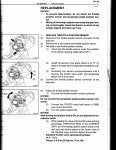Do i have a bad APPS or Throttle Control Motor (TCM)? Or...?
You have a bad APPS (Accelerator Pedal Position Sensor).
Been there, had that, on an '00 Tundra and '01 Sequoia, both with the 4.7L engine.
It is mounted on the passenger side of the throttle body. Replacing it is easy.
Unplug the connector.
Rotate the pully the throttle cable is wrapped around to the full throttle position and unhook the cable from it.
Remove the three screws that hold it on.
Pull it off.
To install the new one, just reverse these steps. You will have to rotate it counterclockwise a bit to slide it in place, then rotate it clockwise to line up the screw holes.
No recalibration is required.
I did notice that in actuating the throttle cable assembly side that the throttle body does not open until just about at the end of its travel and the throttle body "butterfly" is not 100% at the end of its travel (actual throttle position just like the gas peddle). More interestingly is that i cannot make the butterfly open 100% from the passenger side (throttle cable side). I can make the butterfly open 100% from the TPS or drivers side. Weird that i get different ranges of butterfly motion from opposite sides.
It's not weird once you understand how the throttle control works. Refer to the attached .pdf file.
This throttle control system is called a "Drive By Wire" system. The idea is that the gas pedal does not directly control the throttle butterfly, rather the ECU does.
The gas pedal moves a cable, which moves the APPS sensor, which tells the ECU what throttle butterfly position the driver desires. In response, the ECU drives a servomotor (the TCM, or Throttle Control Motor), on the driver side of the throttle body, to open the throttle butterfly to the desired position. Next to the TCM is the TPS (Throttle Position Sensor), which senses the position of the throttle butterfly and provides feedback to the ECU so that it can control the throttle butterfly position precisely. This is an ordinary "closed loop" servomotor control system.
Your APPS is worn, such that it does not properly sense the accelerator pedal position. It is a rotary potentiometer, i.e. a long resistor with a rubbing contact that is mounted to the shaft. Rotating the shaft thus varies the resistance. The rubbing contact is badly worn in places, such that rotating the shaft from "idle" to "full throttle" does not properly result in a measure of its position. In my case (both time), it was a bit "numb" when coming off idle. Yours is more like "dead" until suddenly it makes contact that means "zoom!"
The cable and the mechanism under the APPS serves a "backup" function. In the event the APPS / ECU / TCM / TPS system won't work properly, you can press the throttle down a long way and it will open the throttle butterfly "manually". It won't open it very far, but you can "limp home" with it until you can get it serviced. This mechanism does not come into play at all when the system works normally.
If you need to use the backup system until you get a replacement sensor, just unplug the APPS and drive it, and the worn out APPS won't surprise you.






